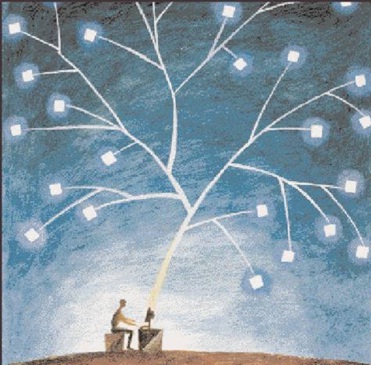Archive for the ‘studyON’ Category
Innovate through connections
Recently I watched an interesting interview with Harper Reed who was the chief technology officer for Barack Obama Presidential election campaign.
Reed describes himself as ‘an engineer who builds paradigm-shifting technology’. He also loves ‘using the enormity of the Internet to bring people together’.
What I really found interesting in this interview is that a self-confessed geek thinks the time has come for innovation to focus less on technology and more on people.
Reed says that technology has been mostly solved. Sure, technology will continue to move at a rapid pace with many more innovations to come. However we at the point now where we need to focus more on how people work with each other. As Reed says, how do you innovate on working with people?
Part of what Reed is interested in here is connecting diverse groups of people. He sees these connections and collaborations as the seeds of innovation.
I once worked with a history teacher who connected his students to the United Nations via live webcasts of the General Assembly. What a simple yet powerful way to connect his students to the world’s foremost organisation for peacekeeping and human rights! What a powerful way to learn at the same time as history is being written!
Connecting people is one of the key components of Jacaranda’s digital products. assessON, Knowledge Quest, myWorld Atlas, myWorld History Atlas, ProjectsPLUS and studyON connect students with their teachers. This enables teachers to track the progress of their students and to diagnose the strengths and weaknesses.
And there is also scope in myWorld Atlas, myWorld History Atlas and ProjectsPLUS to connect students, and their work, with not only their class mates but with students and teachers all over the world!
The technology has largely been solved.
Now the time has come for us to innovate powerful learning experiences by making the connections between learners.
The right conditions for feedback
“Feedback …… is the rocket fuel that propels the acquisition of knowledge and without it no amount of practice will get you there”.
One of the most interesting books I have read on high performance is Matthew Syed’s Bounce.
Syed was England’s Table Tennis Champion for many years and competed at the Barcelona and Sydney Olympics. He now works as a prominent sports journalist in the UK.
Bounce explores what really lies behind world-beating achievement in sport and other walks of life. In doing so, Syed explores the success of a wide range of high achievers including Mozart, Roger Federer, Picasso and David Beckham.
The general view that we have of high achievers is that they are blessed with extraordinary natural ability. However Syed’s central thesis is that natural ability has very little to do with high achievement and more to do with implementing the right conditions for performance.
One of these conditions is purposeful practice and meaningful feedback.
In exploring his own development as a table tennis champion, Syed points out how he was instructed by his coach to change his highly variable forehand stroke. Sometimes his forehand was played with a high arc, sometimes with a bit of sidespin. Syed reasoned that the variation in his forehand made him an inventive player.
However Syed’s coach insisted that the forehand should be identical every time it is played. For two months, Syed’s was instructed to repeat an identical forehand in training so that it is “played with a long sweeping arc, starting from my (Syed’s) right ear and finishing a few inches above my ankle and taken at precisely the same height of the net with exactly with 80 degrees of knee bend” (p. 94). This was practised until it was encoded into Syed’s DNA.
Syed questioned the value of spending so many gruelling hours practising the same stroke without any variations. But with the wisdom of hindsight, he realised his coach was creating the conditions for purposeful practice and meaningful feedback.
With a variable forehand it is difficult to identify what was wrong when Syed made an error was made. However by reproducing an identical stroke, it is far easier to identify technical errors so that corrective refinement and readjustment could be made.
In other words, Syed was empowered with a tool for automatic feedback and a powerful mechanism for learning. In his own words, “feedback …… is the rocket fuel that propels the acquisition of knowledge and without it no amount of practice will get you there”.
When implementing meaningful assessment for our students we also strive to provide the right conditions for purposeful practice and meaningful feedback. If we can provide the right conditions, our students will have tools to identify their strengths and weaknesses and to make refinements. More importantly, purposeful practice and meaningful feedback will help build the capabilities of our students to make effective decisions about their learning.
Jacaranda is committed to providing the right conditions for learning. Purposeful practice and meaningful feedback is deliberately built into all of Jacaranda’s digital-first products including assessON, Knowledge Quest, myWorld Atlas, myWorld History Atlas and studyON.
This feedback loop provides the right conditions for:
- Assessment of learning (to compare what has been learned to what has been taught).
- Assessment for learning (to check what is known and what needs to be known to complete a learning task).
- Assessment as learning (enabling students to self-assess and find out more about themselves as learners).
Whether your students are striving to hit the perfect forehand or solve a difficult equation, purposeful practice and meaningful feedback is vital in all learning contexts. Like Syed’s coach, teachers need to create the right conditions for this to occur.
Your students will thank you for implementing and optimising the right conditions for their learning.
Finishing Kick
The story of Mo Farah’s journey to be an Olympic champion is truly inspirational.
Mo Farah was born in Mogadishu, Somalia. At a very young age, he moved with his brother and mother to Djibouti to escape the civil war in Somalia. Shortly after at the tender age of eight, he moved to Britain to join his London-born father.
Farah’s schooling in London was difficult. He spoke little English. He was one of the few black faces at his school. He struggled academically because of the language barrier. And he desperately wanted to fit in with his peers.
Alan Watkinson, a Physical Education teacher, noticed Farah’s athletic potential and thought that running could be a creative and emotional outlet for his academic and emotional struggles at school. Farah’s well-being became a personal project for Watkinson.
After several years of focused training Farah won the European Junior 5000m title in 2001. He then progressed into the senior ranks representing Britain at European and World Championships. This followed with Farah’s selection to compete in the 5,000 metres at the 2008 Beijing games.
While elated at becoming an Olympian, Beijing was also a bitter disappointment for Farah as he was eliminated in the first round heats. Farah knew that he had not reached his potential and he began searching for the difference that was needed to become an Olympic champion.
In early 2011, less than 18 months before the London games, Farah approached Alberto Salazar, a Cuban-born American coach. Salazar, a former world class marathon runner, set out to identify the strengths and weaknesses in Farah’s previous performances. After assessing a great deal of data, he concluded that Farah didn’t have one ingredient – the tactics and strength to execute a finishing kick to win in the last 100 metres of an Olympic final. So Salazar set about educating Farah about the right time to kick. At the same time, he added 7 hours of gym work every fortnight to Farah’s training program of 110 miles per week.
The rest of the story is history!
Mo Farah won the 5,000 and 10,000 metres in London and is now one of the greatest distance runners the world has seen.
While most of us will never come anywhere near Olympic glory, it is the lessons in Mo Farah’s story that we can take away to inspire our students.
Mo Farah’s success would not have been possible without a teacher at school who changed the course of his life and an astute coach with an eye for detail. Alan Watkinson and Alberto Salazar helped Farah to see where differences could be made.
As teachers we all have the task of helping our students see where a difference can be made. Sometimes the difference can even be life-changing. But, more often than not, the difference is the simple daily advice we give our students.
As the Year 12 exam season looms, there are many students asking their teachers to help them find where differences can be made. Many Year 12 teachers in NSW and Victoria are currently using studyON to help their students find the difference. Teachers are using the monitoring and results tools in studyON to help students diagnose their strengths and weaknesses in exam practice.
Year 12 students are embarking on the last part of their school journey. Like Mo Farah, they are asking for your help with their finishing kick.
Get the most out of studyON in 2012!
The Year 12 exams are over for another year. Some teachers have already expressed their sense of relief to me!
Early in the new year I will be adding tips on this web page as to how you and your students can get the most out of studyON.
By subscribing to this blog, you will automatically receive updated tips and ideas in your email inbox!
 Leave a comment
Leave a comment




